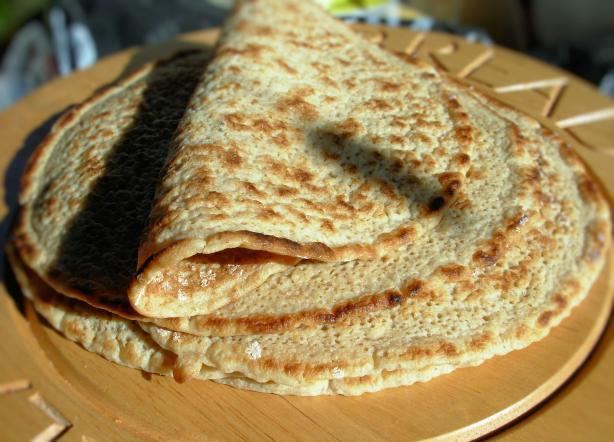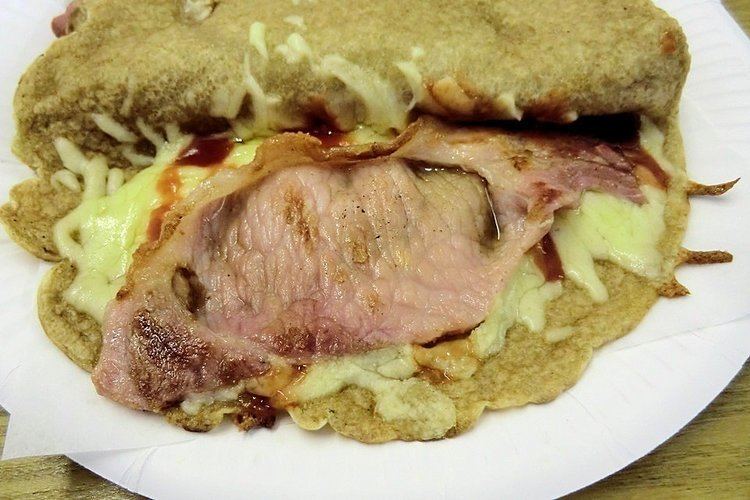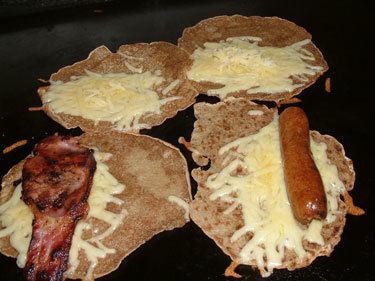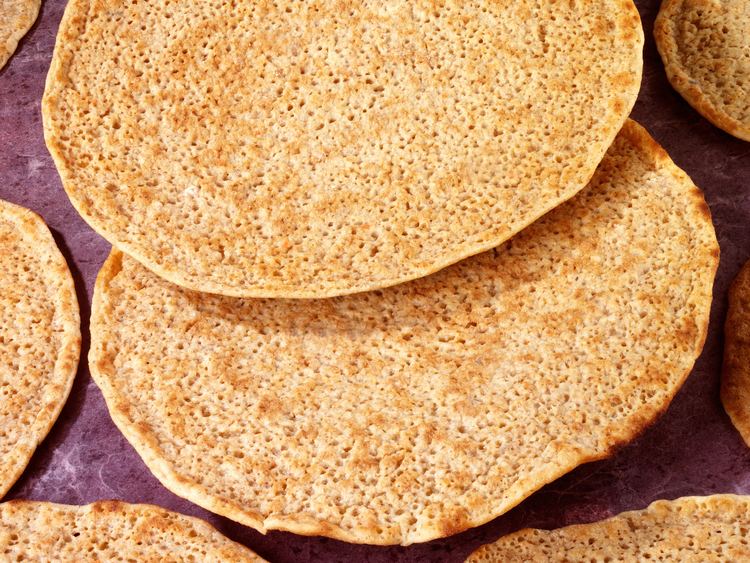Main ingredients Oatmeal | Place of origin England | |
 | ||
Similar Oatcake, Flour, Yeast, Malvern pudding, Squab pie | ||
A Staffordshire oatcake is a type of savoury pancake made from oatmeal, flour and yeast. It is cooked on a griddle or 'baxton'. The oatcake is a local speciality in the North Staffordshire area of England, specifically Stoke-on-Trent. They are normally referred to as Staffordshire oatcakes by non-locals, because they were made in and around Staffordshire and Cheshire; locally they are simply called 'oatcakes'.
Contents
- Staffordshire oatcake recipe
- Derbyshire oatcakes
- Lancashire and Yorkshire oatcakes
- Cooking equipment
- Oatcake Day
- References

It was once common throughout the Potteries for oatcakes to be sold directly from the window of a house to customers on the street. The last producer in this style, the 'Hole in the Wall' in Stoke-on-Trent, closed on 25 March 2012; however, there are many small commercial premises who sell oatcakes, either ready to eat, with a filling, or in batches of half a dozen/dozen for the customer to take home. Larger commercial enterprises exist that sell oatcakes to supermarkets and other large distribution chains.
Oatcakes can be a form of fast food. Catering outlets in the area usually offer oatcakes with fillings such as cheese, tomato, onion, bacon, sausage, and egg. They can also be eaten with sweet fillings such as golden syrup, jam or banana, but this is less common and frowned upon by traditionalists. They are traditionally re-heated by steaming between two plates over a saucepan of water or nowadays by microwave, though some may prefer frying in butter or grilling.

The Staffordshire oatcake is not to be confused with the Scottish oatcake (biscuit) as although both are made from oatmeal the results are very different. The Staffordshire oatcake dates back to the 19th century where it was baked on a hotplate over an open fire.

Staffordshire oatcake recipe
Derbyshire oatcakes
Derbyshire oatcakes are similar to Staffordshire oatcakes, but while following a similar (or even the same) recipe are generally larger in diameter, and thicker. For example, the same recipe will make four Derbyshire or twelve Staffordshire style oatcakes.
Lancashire and Yorkshire oatcakes
A Lancashire oatcake bears a passing resemblance to a Derbyshire oatcake, but is made without wheat flour or milk, and shaped as an approximate 11-by-6-inch (28 cm × 15 cm) oval, smooth on one side and rough on the other, and traditionally cooked on a bakestone. It may be eaten moist, rolled up like a pancake with a filling, or dried hung over a rack until a crisp cracker. The dried version served with a beef and cowheel stew is known as "stew and hard". Once common throughout Lancashire, it is now rarely found. The same cake is also cooked in West Yorkshire and Craven so is sometimes referred to as the Pennine Oatcake. Yet in Yorkshire the recipe often incorporated ca. 20% buttermilk.
In Lancashire and Yorkshire oatcake was a staple of the diet up to ca. 1910 Up to the 18th century Oatcakes were often called havercakes, from hafr the Old Germanic word for oats, but that name only continued to be used in the North Riding of Yorkshire and Teesside for a different kind that is thick with no yeast. The word is perpetuated in the nickname The Havercake Lads for the 33rd Regiment of Foot and also in the term Haversack.
Cooking equipment
In Lancashire and the West Riding of Yorkshire the griddle was called a bakstone. Originally a bakstone was a portable flat oval flaggy sandstone ca.1.5-inch (3.8 cm) thick, set on an open fire. In the 19th century these became replaced with a cast iron plate with a hooped handle, yet its name remained unchanged. In large houses they were built-in adjacent the chimney, with a firebox under an iron plate that was ca.3-foot (91 cm) by 1.5-foot (46 cm), or in larger houses a pair of 2-foot (61 cm) square plates.
In the 18th century the batter was mixed in a small wooden bucket which was not cleaned, so that the particles on the sides acted as a fermenting agent for the next baking. In the 19th century they switched to baker's yeast and porcelain containers or enamel pails.
The size of the ladle varied relative to the current cost of oatmeal; for over decades oatcakes were by tradition one penny each, or 18 for a shilling.
Before ca 1860 the method was called thrown oatcakes or riddlebread. The baker sifted oatmeal on the riddleboard, poured on a ladleful of batter then, by a circular horizontal movement, spread and levelled the batter. It was then slid onto a piece of linen covering the spittle board, a board with a handle. The cake was thereby thrown (flipped) on to the bakstone and then the linen taken up.
Baking racks were contrived by turning a chair on its side and covering the legs with a white cloth.
Oatcakes made for drying were left until crisp on a fixture called the bread flake. Flake pronounced fleeak is from the Old Norse fleki meaning a hurdle. Flakes in Wharfedale had wooden laths e.g., one at Ling House measured 10.5-foot (3.2 m) by 4.5-foot (1.4 m) with 23 cross bars. Those in upper Ribblesdale had strings, over two of which each cake was laid. In some areas the rack was called a bread creel
Oatcake Day
An Oatcake Day event was held on Sunday, 8 August 2010. This has led to other events such as Oatcake Camp which take place on the same day.
